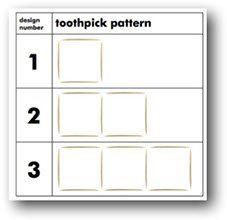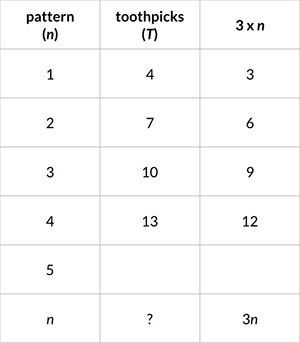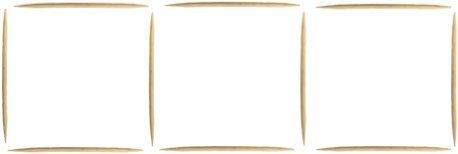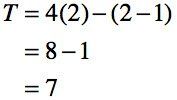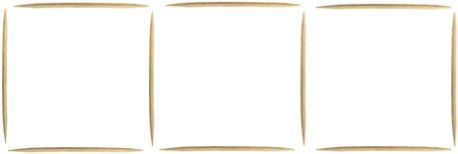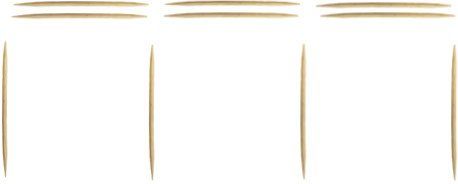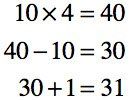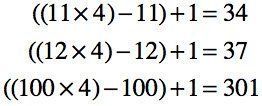How Do You Generate Equations from Patterns?
In the Poster Problem "Toothpick Patterns," students write symbolic expressions for the numbers of toothpicks in a sequence of designs. The first three designs appear in the illustration at right.
This is the creative part of algebra. It’s not as straightforward as plugging in values for variables or manipulating symbols—it’s actually inventing the formulas instead of simply using them.
Students should not simply stumble around in the mathematical dark until they bump into a solution, though: there are strategies to learn.
One strategy is to look for a pattern in the numbers, separate from the situation. Suppose the pattern is
{ 4, 7, 10, 13, … }.
If you put it on a number line, it looks like this:
Students might notice a difference of three between any two adjacent numbers. This difference suggests that the solution will have something to do with multiplying by three. Encourage students to make a table rather than try to figure it out in their heads.
By making the table, students will see that the relationship jumps right out: the number of toothpicks (in the middle column) is one more than the the right-hand, 3n column. So the formula is T = 3n + 1.
We developed that expression just by looking at the numbers. But doing so still requires the “leap” of deciding to multiply by three, and gives no insight into what three has to do with toothpicks. Why three?
Which brings us to the other strategy: looking more deeply at the pattern in the toothpicks.
There are many approaches here, all good. This is the point of the problem: that there are a number of good formulas, all of which lead to the same correct result. Encourage students to come up with as many as possible.
Let’s do an example. We’ll start by looking at the third toothpick pattern:
It looks like three attached squares. If we made three separate squares, it would look like this:
The three squares would require 12 toothpicks. In fact, if we made separate squares in every pattern, the formula would be easy: T = 4n, because there are n squares and four toothpicks in each square.
But the squares are not separate. How do we fix the formula? In our picture, you can see that there are two places with “double” toothpicks. To turn the second diagram into the first one, we have to remove two toothpicks—one from each double. That gives us 10 toothpicks, which is correct.
How many toothpicks do we have to remove if we’re looking at a toothpick pattern with a different number of squares? One less than the number of squares. That is, the number of toothpicks is what we need for n squares, minus (n – 1). That gives us the formula
Let’s check this formula for n = 2:
Correct! Let’s do another one. Here’s the third toothpick pattern again:
Let’s look at it as two horizontal lines, with connectors, like this:
Each horizontal line has n toothpicks, so the two horizontals are 2n (six in this case). How many vertical connectors? One more than the number in the horizontals, or (n + 1). This yields:
If you check this formula for n = 2, you get 7 as well. In fact, both of our formulas give the same result no matter what value you use for n. They are equivalent. And if you simplify them, you get T = 3n + 1 in each case.
Is T = 3n + 1 the one right answer? No: all of the formulas are correct. It’s true that T = 3n + 1 is the simplest, and in most cases, it will be easier to use than other formulas.
To use this strategy, you need to figure out when to use n and when to use an actual number. The key is to imagine other patterns while you’re looking at the one with three squares.
Also, students may notice that you’re combining simpler patterns that use addition and multiplication. For our second example, the formula for the horizontals is easy: H = 2n; the formula for the verticals is V = n + 1. And T = H + V.
But notice what may be the most important thing: by reasoning from the toothpick designs, we’re discovering the reasons behind the number patterns and therefore the reasons behind the formulas. If you just look at the numbers, you may get a good formula, but you may have no idea why it works.
How can you approach this if you have trouble with the abstraction?
Some students will have trouble connecting the variable n—the pattern number, in this case, also the number of “squares”—to the formula and the process of calculation. Many times they can recognize the pattern and how it works, but just can’t convert that knowledge into a formula.
A student might, therefore, be able to find the number of toothpicks in the 10th design (31) without using the formula and without simply counting. Probe the student’s understanding. How do they explain their reasoning? Does it come from the numbers only, or from the visual pattern?
For example, suppose they say,
“The tenth design has 31. That’s because it’s 10 squares. And that’s 40 toothpicks, but there are doubles, so we have to remove one for each square. So you subtract 10 and get 30. But then you’ve taken away one too many so you have to add it in. That’s 31.”
Ask them to write the calculation down. Some students may write this very dangerous “rolling equation”:
First, have them separate the statements so they are actually true!
This sequence of equations may seem inefficient to students. But now we’re going to combine the number statements into one. In the last statement, where does the 30 come from? Ah, the line above. That line states that 30 is the same as 40 – 10. So we can substitute and get:
Unlike the rolling equation, this equation is actually correct. Then we do the same with the 40, and substitute from the first line:
Now have the student do repeated calculations using their technique, on paper, showing the relevant form of this particular expression, like this:
Now the pattern becomes clearer. What stays the same in each calculation? Multiplying by four, adding one.
What changes in each calculation? The 11, the 12, the 100—and each appears twice. Each of these numbers is the number of the design. That’s n, so we can substitute and get:
Abstraction is hard, and there are many stumbling blocks. This is just one example, but it does illustrate some principles:
Substitution is a powerful conceptual idea—and “rolling equations” can get in the way.
- A formula is generalized arithmetic: the whole point is to describe your calculation so it works with any number.
- Write your calculations down correctly for several designs. See what stays the same and what changes. What stays the same will be the same in your formula. Connect the number changes to your design number, and substitute.
- Develop the pattern with concrete examples first. You don’t have to introduce n, the number of the design, until late in the process. After all, n is an abstraction, so it’s developmentally difficult for students to comprehend.
Multiplying or Adding?
Early in the first discussion, we wrote, “Students might notice a difference of three between any two adjacent numbers. This difference suggests that the solution will have something to do with multiplying by three.”
That’s not obvious. In fact, it’s reasonable to say that the difference of three means that we should look for adding three rather than multiplying.
This “adding” perspective is fine—but it doesn’t fit what the curriculum is usually asking for at this level. Still, it’s a genuinely good approach, so let’s take a moment to discuss it using official mathematical terminology.
Thinking about the sequence as adding instead of multiplying uses what is called a recursive approach. The formula you would come up with is:
That is, the number of toothpicks in the nth design (Tn) is equal to the number of toothpicks in the previous design—the (n – 1)st design—plus three. This formula works for any number in the pattern, except for the first one. So we need an additional, simple formula:
That is, there are four toothpicks in the first design.
With those two formulas, we can figure out the number of toothpicks in any design. The problem is, it may take a while. To find the number in the 100th design, for example, we need the number in the 99th design; to get that, you need the 98th, and so forth, until you get down to the first design—and that’s four toothpicks.
So in this situation, our other formula (called an analytic formula), namely,
is a lot easier to use. Just plug in 100 for n, and you get 301 toothpicks.
So for this toothpick problem, we prefer the analytic formula because it’s easier to use. But both the analytic and recursive formulas are valid.
There are even situations where the recursive formula is easier, or more appropriate—or cases where it’s too hard to figure out an analytic formula. One of these is the Fibonacci sequence, which we define recursively, like this:
What’s the 10th Fibonacci number? It’s easiest simply to write them out.
1, 1, 2, 3, 5, 8, 13, 21, 34, 55…
